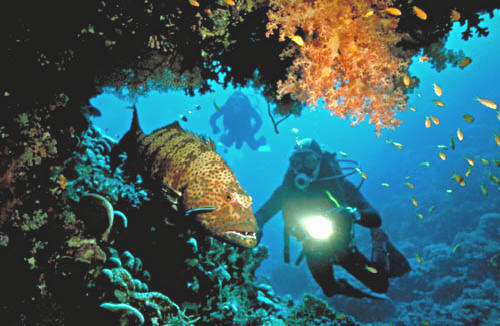Safaga: Great Dive Sites
|
|
   |
Site: The
Salem
Express
Max Depth: 34
m.
Visibility: 40 m.
Dive Type: Wreck. |
|
Notes: The
Salem
Express is a dramatic dive. Around 500 people perished in
one of the worst marine tragedies of all times. The
100-meter ferryboat was on its way back from
Mecca
to Safaga after the annual Muslim pilgrimage in December
1991, when it hit the reef during a stormy night and sunk
rapidly without giving the opportunity to the crew and
passengers to board the lifeboats. It is now home to a
thriving underwater life, including a famous resident
frogfish, blue-spotted stingrays, angel and butterfly fish.
The ship itself is covered in a large quantity of hard and
soft corals. It was sealed after the rescue operations, so
some of the sights are poignant and moving: a small baby
trolley, a stereo and a suitcase. It is one of the largest
wrecks in the Egyptian
Red Sea - roughly the
same size as the Thistlegorm. Note that although it is
officially permitted to dive this wreck, many dive guides
may refuse
|
|
Site: Sha’ab
Sheer
Max Depth:
40
Visibility: 40 m.
Dive Type: Moored / Drift dive
|
|
Notes: Its southern lagoon is a favorite night
stop for live-oards due to the shelter offered by the 2 km
of barrier reef stretching from East to West. Great diving
is found on these two tips, with a wealth of acroporas and
fire coral with schooling jacks, snapper and tuna fish. Off
the Western tip, dolphins playing in the open sea currents
are a common sight. When they have babies though, they tend
to rest in the southern shallow lagoon, making for
unforgettable encounters with divers and snorkelers alike.
The northern side of the barrier offers good drift dives
with some caves and a drop off down to 40 meters. |
|
Site: Panorama Reef
Max Depth:
Plateaus at 40 m. with drop offs down to more than 200 m.
Visibility: 50 m.
Dive Type: Drift / Moored dive
|
|
Notes: Another highlight of the area,
similar to Abu Qifan, but bigger! It is in fact one of the
largest reefs in Safaga, featuring numerous grottos and
overhangs, where gorgonians and soft corals thrive with the
frequent nurturing currents. Due to the size of the barrier,
there are at least three different dives to be done here:
the south plateau and the east and the west drop offs. As in
Abu Qifan, besides the huge coral formations with walls
plummeting to 200 meters, jacks, barracudas and white tip
reef sharks and occasionally hammerheads and manta rays can
be found. The south plateau is somehow more protected by the
current.
|
  |
|
Site: Hal Hal
Max Depth: 80 m
Visibility: 40 m.
Dive Type:
drift / Moored dive
|
|
Notes: Next to Middle Reef, it is a rarely
chosen dive site due to its distance from the coast, which
makes of it a virgin spot. The north side is a drop off
going down to 80meters, and is a perfect location to spot
tunas, barracudas, turtles and sharks. The southern side has
colorful coral gardens along with some caves and canyons.
This dive site is mostly available only from a live-aboard
|
|
Site: Middle Reef
Max Depth: Drop off over 60 m.
Visibility: 50 m.
Dive Type: Moored dive / only with good weather conditions
|
|
Notes: As per Hal Hal, this open sea reef presents frequent
currents, which create a fabulous underwater habitat. It is
famous for its beautiful brain coral garden on the southeast
plateau. From the drop-off at northeast, you can usually see
pelagics such as tunas along with grey and white tip sharks.
Sometimes, you can even spot a family of hammerheads.
|
|
Site: Abu Qifan
|
|
|
Max Depth:
Plateaus at 30 m., drop offs down to more than 200 m.
Visibility: 40 m.
Dive Type: Barrier Reef – Drift dive
|
|
Notes: Legendary for hammerhead sightings in
late spring and manta rays in wintertime, it is by far my
favorite dive in Safaga. This 300-meter long and narrow reef
offers a plateau in both north and south tips. We normally
jump in the water on the north plateau and glide with the
frequent strong current southwards along the impressive
walls covered with soft and black coral, giant fans and
gorgonians. Along the sheer walls the resident white tip
reef sharks observe divers with aristocratic
indifference. Schools of barracudas can be seen
frequently spiraling out in the blue. Turtles also have
chosen this opensea reef as permanent residence.
|
 |